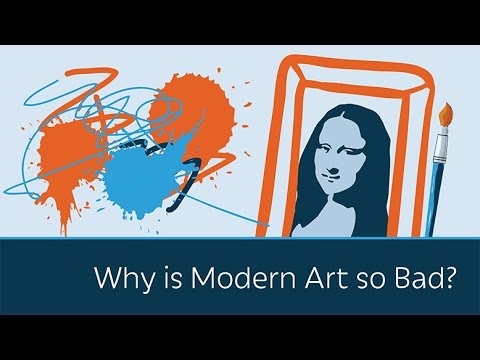“The Mona Lisa”… “The Pieta”… “The Girl with a Pearl Earring.” For a score of centuries, artists enriched Western society with their works of astonishing beauty. “The Night Watch”… “The Thinker”… “The Rocky Mountains.” Master after master, from Leonardo, to Rembrandt, to Bierstadt, produced works that inspired, uplifted, and deepened us. And they did this by demanding of themselves the highest standards of excellence, improving upon the work of each previous generation of masters, and continuing to aspire to the highest quality attainable.
But something happened on the way to the 20th Century. The profound, the inspiring and the beautiful were replaced by the new, the different, and the ugly. Today the silly, the pointless, and the purely offensive are held up as the best of modern art.
Michelangelo carved his “David” out of a rock. The Los Angeles County Museum of Art just offers us a rock, — a rock — all 340 tons of it. That’s how far standards have fallen. How did this happen? How did the thousand-year ascent towards artistic perfection and excellence die out?
It didn’t. It was pushed out. Beginning in the late 19th century, a group dubbed The Impressionists rebelled against the French Academie des Beaux Arts and its demand for classical standards. Whatever their intentions, the new modernists sowed the seeds of aesthetic relativism — the “beauty is in the eye of the beholder” mentality.
Today everybody loves the Impressionists. And, as with most revolutions, the first generation or so produced work of genuine merit. Monet, Renoir, and Degas still maintained elements of disciplined design and execution, but with each new generation standards declined until there were no standards. All that was left was personal expression.
The great art historian Jacob Rosenberg wrote that quality in art “is not merely a matter of personal opinion but to a high degree . . . objectively traceable.” But the idea of a universal standard of quality in art is now usually met with strong resistance if not open ridicule.
“How can art be objectively measured?” I’m challenged. In responding, I simply point to the artistic results produced by universal standards compared to what is produced by relativism. The former gave the world “The Birth of Venus” and “The Dying Gaul,” while the latter has given us “The Holy Virgin Mary,” fashioned with cow dung and pornographic images, and “Petra,” the prize-winning sculpture of a policewoman squatting and urinating — complete with a puddle of synthetic urine.
Without aesthetic standards we have no way to determine quality or inferiority. Here’s a test I give my graduate students, all talented and well educated. Please analyze this Jackson Pollock painting and explain why it is good. It is only after they give very eloquent answers that I inform them that the painting is actually a close up of my studio apron. I don’t blame them; I would probably have done the same since it’s nearly impossible to differentiate between the two.
“And who will determine quality?” is another challenge I’m given. If we are to be intellectually honest, we all know of situations where professional expertise is acknowledged and depended upon. Take figure skating in the Olympics, where artistic excellence is judged by experts in the field. Surely we would flinch at the contestant who indiscriminately threw himself across the ice and demanded that his routine be accepted as being as worthy of value as that of the most disciplined skater.
Not only has the quality of art diminished, but also the subject matter has gone from the transcendent to the trashy. Where once artists applied their talents to scenes of substance and integrity from history, literature, religion, mythology, etc., many of today’s artists merely use their art to make statements, often for nothing more than shock value. Artists of the past also made statements at times, but never at the expense of the visual excellence of their work. It’s not only artists who are at fault; it is equally the fault of the so-called art community: the museum heads, gallery owners, and the critics who encourage and financially enable the production of this rubbish. It is they who champion graffiti and call it genius, promote the scatological and call it meaningful. It is they who, in reality, are the naked emperors of art, for who else would spend $10 million dollars on a rock and think it is art.
But why do we have to be victims of all this bad taste? We don’t.
By the art we patronize at museums or purchase at galleries, we can make our opinions not only known but felt. An art gallery, after all, is a business like any other. If the product doesn’t sell, it won’t be made. We can also support organizations like The Art Renewal Center that work to restore objective standards to the art world. And we can advocate the teaching of classical art appreciation in our schools.
Let’s celebrate what we know is good and ignore what we know is not.
By the way, the white background you see behind me is not simply a white graphic backdrop. It is a pure white painting by noted artist Robert Rauschenberg at the San Francisco Museum of Modern Art.
I’m Robert Florczak for Prager University.
